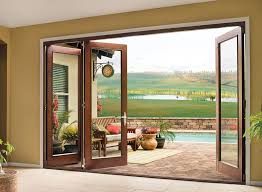Sunview Windows and Doors manufacture windows in their Saskatoon factory. They install new and replacement windows for homeowners and businesses in Saskatoon and across Saskatchewan. They also sell high quality doors, security shutters and blinds. In addition, they also manufacture solariums (also called sunrooms), screen rooms, conservatories and patio covers via their sister company, Sunview Solariums Ltd. Sunview Windows and Doors are Trusted Saskatoon Window, Door & Sunroom Experts.

Sunview Windows and Doors Tip on Patio Door Ideas and Options
We strive to be your local experts when it comes to windows and doors. We also want to share our passion for our products with you too, so now we have a Sunview blog to do just that!
In this article, you will learn about new options and patio door ideas for attractive, functional doors.
Patio Doors

Your outdoor living space is an extension of your home, and that is why you’ll want to consider a variety of options and patio door ideas before finalizing your project.
One of the most common patio door options is the French patio door. This style incorporates glass window panes in the door, allowing an unobstructed view from the home’s interior to the outside space and vice versa. It can create a natural transition from the inside to the patio. French patio doors are usually available in wood, fibreglass and PVC, and they can be configured as either swinging or sliding doors.
Sliding Patio Doors
 Whereas French patio doors are a more traditional approach, contemporary sliding doors have a more modern look. These doors offer greater simplicity in that they create no obstacles at all to furniture placement, inside or out. Patios are generally gathering places for family and friends, and when lots of people are involved, a traditionally open and close door can be a hindrance to entering and exiting. Just ask anyone who’s tried to carry a tray of appetizers through a traditional door while a gaggle of toddlers is racing in or out. For this reason, and because they can add a modern, elegant design element to connect your outdoor and indoor space, sliding patio doors are a popular option.
Whereas French patio doors are a more traditional approach, contemporary sliding doors have a more modern look. These doors offer greater simplicity in that they create no obstacles at all to furniture placement, inside or out. Patios are generally gathering places for family and friends, and when lots of people are involved, a traditionally open and close door can be a hindrance to entering and exiting. Just ask anyone who’s tried to carry a tray of appetizers through a traditional door while a gaggle of toddlers is racing in or out. For this reason, and because they can add a modern, elegant design element to connect your outdoor and indoor space, sliding patio doors are a popular option.
In the past, sliding patio doors were heavier and had a reputation for getting stuck in their tracks or misaligned. Modern sliding patio doors generally offer a much slimmer, more contemporary look, and the problems of sticking and misalignment have been lessened. Because of the lighter materials, these new designs generally offer a larger, less obstructed viewing area as well.
Folding Patio Door
Designed with three or more panels, these doors fold upon opening and slide on a track, similar to sliding doors. Folding patio doors can create a unique visual aesthetic and are often a good fit for more modern patio designs. 
Whatever option you prefer the look of, you need to ensure that it will work for your home and your family… that's where we come in! The Sunview Windows and Doors team are skilled professionals. Our goal is to provide the best possible experience from beginning to end!
Contact us today to start planning your patio door dreams!
Sunview Windows and Doors are Trusted Saskatoon Window, Door & Sunroom Experts
As their tagline clearly explains...
We build them – We install them – We stand behind them